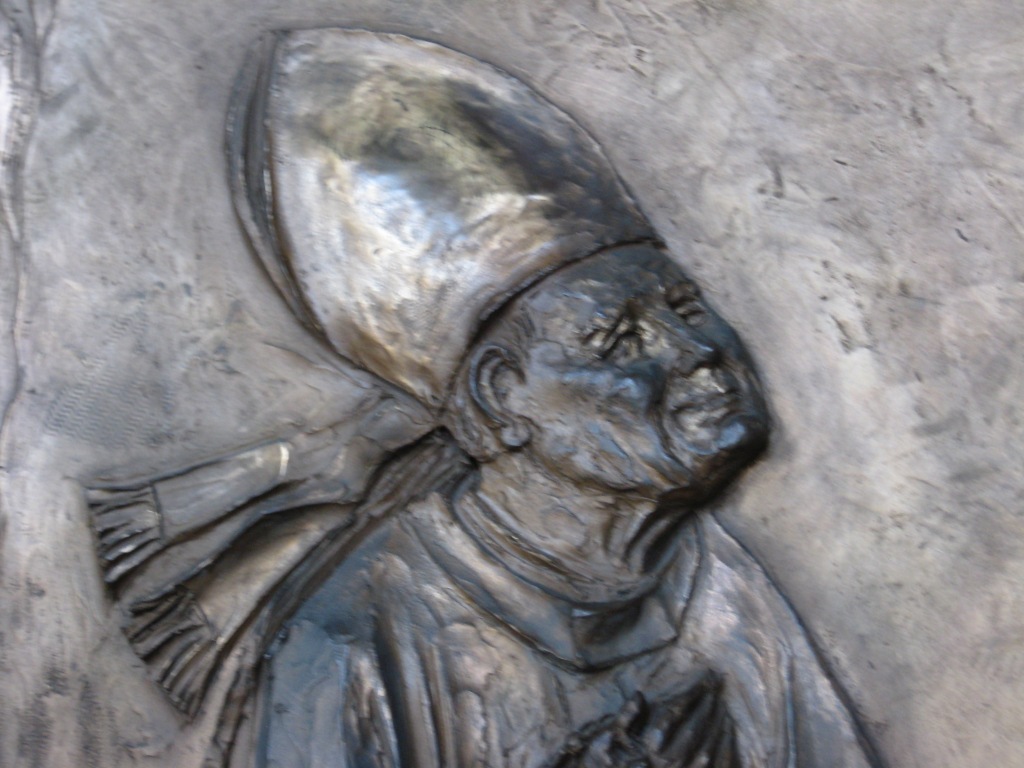
Fr. Bernie said that “Blessed Pope John Paul II is a favorite of our pilgrimage group. Here his image is found on the door to the Basilica of St. Mary Major.”
As noted previously, Fr. Bernie Rosinski, SCJ, is among those on a pilgrimage to Rome organized by the province development office. Today he writes about several visits of the group in the city, as well as Mass celebrated at the Generalate:
The group visited a number of places and saw a variety of masterpieces or historical artifacts: St. Peter in Chains (the Moses of Michelangelo and the chains that bound St. Peter in the Mamertine prison before his execution on Vatican Hill); the Coliseum, erected by Emperors Vespasian and Titus to wipe out all traces of the Emperor Nero’s highly unpopular and cruel domination of Rome; the Roman Forum down through the centuries before Roman civilization really took hold under the emperors and after; St. Mary Major, the last of the four major basilicas of Rome visited by our group (cradle of Jesus and historical mosaics dating back to 6th century and later).
Francesco, our guide, was very capable in English and spoke with an American accent. He was extremely knowledgeable and told us he “loved to talk.” It was for this reason we obtained truly extensive explanations of the many places we visited and their features. He may be our tour guide again on Sunday; at least the group hopes so.
The group was treated to a talk by Fr. John van den Hengel, the Vicar-General of the Priests of the Sacred Heart, on the international scope of the congregation. After, was a Mass concelebrated in English by the superior general of the congregation, Fr. José Ornelas Carvahlo.
Fr. General also gave our pilgrimage group a talk with slide illustrations that described the status of the Congregation of the Priests of the Sacred Heart worldwide. It was fascinating in its presentation of how the congregation and the church is moving toward the southern hemisphere, the aging patterns of the northern hemisphere. We who have been present at general chapters and conferences are familiar with the statistics but it was an eye-opener for the pilgrim group.
We citizens of any particular place have a tendency to localize our interests and neglect what is happening elsewhere. Our media has a tendency to note particular events; trends and directions are less concrete and therefore not part of what we hear on TV or read about in our newspapers and magazines. That was remedied by Fr. General’s presentation. Several members of the group asked pointed and intelligent questions afterwards. They seemed very interested in what was happening in the church. At the end of the presentation Fr. General thanked the people for their support of the SCJs in the United States and noted that much of what we are able to do worldwide comes from the support of the U.S. Province.
The end of the day saw a dinner hosted by the Priests of the Sacred Heart for the pilgrim group in the community dinning room. Along with visible evidence of the internationalization of the congregation seated at table (students and curia staff from 17 of the 41 nations in which the Priests of the Sacred Heart are found worldwide), the pilgrim group enjoyed a meal of lasagna, peas, string beans, potato fries, and chicken along with an Italian tort and aperitifs of several kinds for dessert. What many pilgrims found amazing was the fact that the food was served by the Superior General, general councilors, curia staff and students. And the same cleared the dishes away afterwards.
In their turn, many SCJs present were fascinated by S. Natividad, the group’s 92-year-old pilgrim. They spoke to her, teased her, and were teased in turn. This gracious lady was a great source of pride to her three daughters who accompanied her on the pilgrimage. Fr. General chose to sit at her side.

